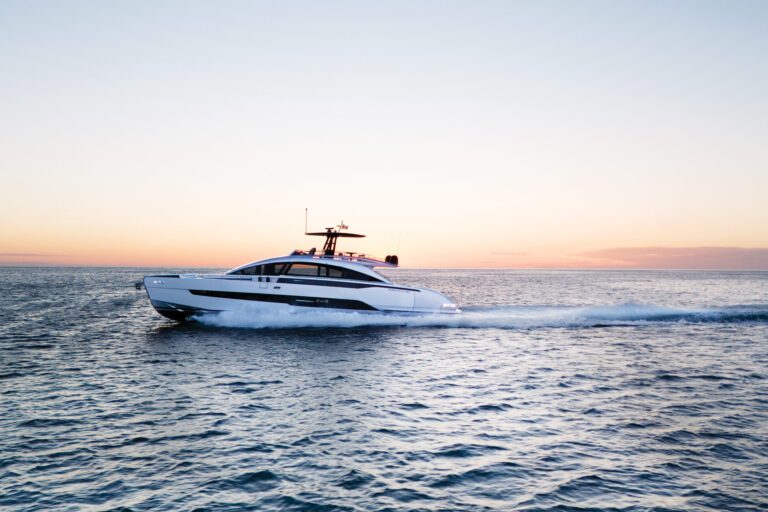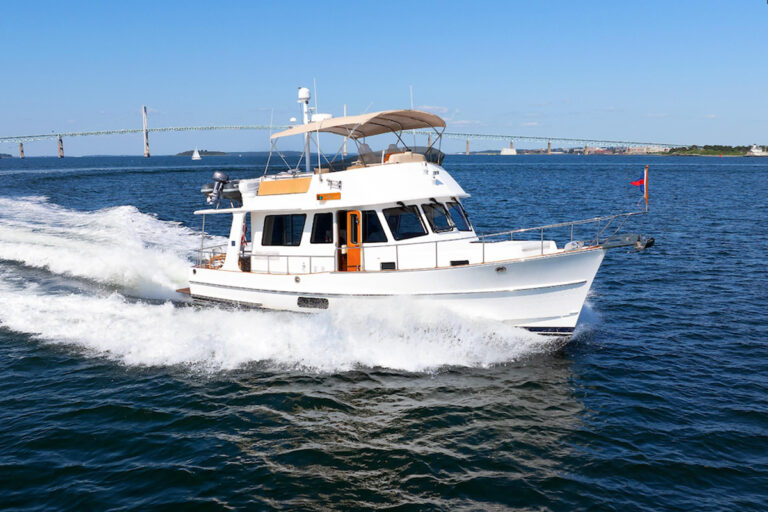The typical American golf getaway begins with more logistics than a shuttle mission. Four busy men scramble to find four consecutive days when business, soccer games, wives and yardwork can be set aside. Then they must agree on a locale. Seashore? Mountains? Desert? Ireland? Scotland?
A desire to avoid further complications caused by moving among towns, courses and hotels probably keeps most groups parked in the same resort, eating at the same restaurants, draining the same mini-bars and staring at the same pink stucco walls at night while the ice machine chatters outside the door. That’s a sub-par environment for celebrating a great round or patching up a damaged ego from a bad one.
A more civilized golf escape might be had playing great courses along the temperate southeast coast of the United States, in a different locale each night, and returning to comfortable accommodations aboard a yacht with a first-class chef and crew dedicated to serving only you and your mates. I sampled such a trip last spring on a charter from Sea Island, Georgia, to Beaufort, South Carolina, aboard a beautifully restored 77-foot 1929 classic motoryacht called Belle. I’ll never look at a golf outing the same again.
Combining golf and yacht charter is not new. A number of charter yachts cater to golfers, and most charter brokers can arrange combination trips. Belle offers term charters, with or without golf. We played private clubs, but if you don’t care for the hassle of making your own arrangements, you might want to consider Belle’s partnership with Atlanta-based Perry Golf. The company specializes in unique and exclusive international golfing vacations, and arranges outings by chartered jet, yacht, helicopter, motor coach and cruise ship.
In conjunction with Perry, Belle offers three-, five- and seven-night golf/cruising packages in spring and fall along the Intracoastal Waterway from Charleston, South Carolina, to Jacksonville, Florida. Clients can choose to play first-class public courses or customized itineraries. Perry handles the details and delivers you to and from the course. Belle’s crew fills in the blanks.
My stay aboard Belle called for a round at the Ocean Forest Golf Club on Sea Island, a cruising day up the ICW with a night at anchor, a round at another private club outside Beaufort and a full day of golf, boating and shooting at a private club near Beaufort called Cherokee Plantation. The pace was quick, but the payoff was great.
The par 72 Ocean Forest is a links-style course designed by well-known golf course architect Rees Jones. It’s a luscious, subtropical layout that runs through woods, dunes and salt marshes and finishes along the seashore. On the practice tee, I joked to the rest of my foursome that I had just two rules: They had to help me chase my balls in the woods, and they couldn’t laugh at my persistent slice. They agreed on the slice, but wisely said no way on the ball hunt.
Our host, Mark Bedner of Sea Island, played a tour-grade round. His partner, Calvert Huffines, a native South Carolinian, made a respectable showing, and my traveling companion, Jim Wille of New Canaan, Connecticut, proved you don’t need to spend a thousand bucks on clubs to make par.
I, on the other hand, was down about a dozen balls after the fifth or sixth hole. After several forays into the dense tidewater vegetation that lines the fairways, I figured out why no one was in a hurry to help me chase balls. The place was thick with reptiles. A couple of adventures into the bush and I decided to forget about it. Taking the strokes wasn’t going to hurt my triple-digit score anyway. After a while, the caddy stopped giving me club advice and started directing me to photo ops of the alligators in the hazards and the bald eagles nesting along the fairways.
Ocean Forest’s signature holes are the seaside 16th, 17th and 18th. The par 4 17th sports nine tees to accommodate the sea breeze that can howl off the Atlantic. According to Bedner, George Bush hit his last presidential golf ball-the ones with the little eagle on them-into the swamp short of the hole. After Bush moved on, a Secret Service detail combed the weeds, found the ball and later presented it to him in a glass case.
My shot landed in the same mess. The caddy scoured the area and found lots of balls, but, of course, mine was not among them. As consolation, I posed for a photo in the same spot on the green at the 18th where the 2001 Walker Cup participants will mug for the camera.
After a round like that, I would have enjoyed having the anxiety pounded or steamed out of me at the spa at the Cloister, a sprawling resort which, like Ocean Forest, is owned by the Sea Island Company. But there’s no better tonic than going back to a yacht like Belle and absorbing the sunset from her party deck.
Belle began life as Madge III. The New York Yacht, Launch & Engine Co. built her for a member of American Yacht Club in Rye, New York. After spending her early years in the Northeast, she was moved south and went through a succession of owners in Virginia, Florida and the Carolinas.
Today, she flies the burgee of the New York Yacht Club. Her owner, McMillen Yachts Inc., and partners had her extensively restored at the International Yacht Restoration School in Newport, Rhode Island, her summer home. Earl McMillen, president of McMillen Yachts, has organized the restoration of six classics, both power and sail. He raises money for the restorations selling partnership shares in the yachts. In addition to some tax benefits, partners receive discounted rates on charters on any boat in the fleet.
Belle feels as good inside as she looks out. She sleeps eight in four simple, tastefully appointed, air-conditioned staterooms. Her saloon, paneled in Honduras mahogany, oozes Jazz Age elegance. As we moved about, we were very much the focus of attention from everyone we passed.
Jim and I spent the morning of our first full day shooting clays at the Sea Island Shooting School, another Cloisters/Sea Island Co. facility. Under the skilled tutelage of shooting school director Justin Jones, we explored the subtleties of skeet and five-stand. After a brief stopover on Little St. Simons Island, a rustic resort with 10,000 acres of wildlife preserve and a seven-mile beach, we headed north.
The Intracoastal Waterway in Georgia and South Carolina winds through some of the prettiest coastal marshlands in America. The development-averse geography has left the place mostly to the wildlife. Along our 100-mile route to Beaufort, we were rarely without the company of waterfowl, osprey, dolphins, turtles, alligators or rising fish. We passed more shrimpers than yachts.
An unplanned diversion into the shallows caused us to miss our tee time at the club near Beaufort, but another full day of getting intimate with the Low Country was not hard to swallow, nor was the cuisine aboard Belle.
Belle’s chef, Gale Tolan, a hired gun from Wilmington, North Carolina, kept us happy, but not too fat. She accommodated the low-carb, high protein diet I was on with panache. Her offerings reflected the marvelous meat- and seafood-oriented cuisine typical of the Carolina Low Country. Entrees included pan-seared soft-shell crabs with lemon-shallot glaze and red pepper coulis, and grilled New York strip with an herb and spice treatment that sent us into the sensory stratosphere. Skipper Craig Callahan and mate Hannah Tragis were accommodating and professional.
Cherokee Plantation is a sportsman’s Shangri La. Dating back to 1710, the plantation produced rice and a variety of agricultural products. It experienced hard times during and after the Civil War, but in the early part of the 20th century, a wealthy industrialist bought it and recast it as a sporting estate. Frederick Law Olmstead’s firm designed the grounds. For some years, Cherokee was owned by the family of Calvert Huffines, our fourth at Ocean Forest. Another former owner was the president of the former American Motors Co., hence the name of the ubiquitous Jeep Cherokee.
In recent years, the plantation was bought by investors led by Peter de Savary, who fielded a British America’s Cup campaign in 1983. Today, Cherokee comprises 4,000 acres, part of a 350,000-acre conservation area called ACE Basin. It operates as a private club with investors permitted to use the 31-room Georgian mansion and staff, and to build cottages on the property. The plantation offers riding, hunting, fishing, boating and shooting, a spa and, of course, golf.
Donald Steel designed the golf course at Cherokee. Like Ocean Forest, it is a links-style course that relies primarily on nature to provide trouble. The pastoral feel of its fairways lined with rail fences and ancient live oaks dripping with Spanish moss, its impossibly high-sided bunkers and the contorted contours of its greens would test golfers of any skill level.
After golf, we aired out with a ride up the Combahee River in a beautifully restored classic launch, then headed off for a round of sporting clays. The Cherokee shooting facility is sponsored by the famous English gun-maker Purdy. Unlike golf, clay shooting rewards high scores. I confess, I had more fun swinging Huffines’ Purdy .410 than I did my new driver.
Drinks on the veranda under the fan while talking birds, dogs, guns and golf with Huffines, who now manages Cherokee’s operations, was a fitting end to a sporting day and perfect warm-up to a fine meal in the formal dining room. We shuttered the day with a glass of port and a Havana cigar in a drawing room adorned with classic sporting art.
Golf can be a troublesome way to relax, but a nurturing 19th hole like Belle and the molasses-sweet atmosphere of the Georgia and Carolina Low Country can make the pain fade quicker than my best tee shot.
Contact: Northrop & Johnson Worldwide Yacht Charters, (800) 868-5913; fax (401) 848-5540; njricharters-@edgenet.net; www.nandj.com; or any charter broker. Belle’s golf packages start at $2,895 per person (three nights) based on four passengers. Northrop & Johnson has information about McMillen partnerships. For information on Cherokee Plantation, call (843) 844-9902.





